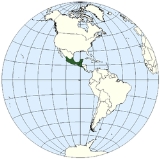
Mesoamerica
Overview
Mesoamerica is a region
and culture area
in the Americas
, extending approximately from central Mexico
to Belize
, Guatemala
, El Salvador
, Honduras
, Nicaragua
, and Costa Rica
, within which a number of pre-Columbian societies
flourished before the Spanish colonization of the Americas
in the 15th and 16th centuries.
As a culture area, Mesoamerica is defined by a suite of cultural traits developed and shared by its indigenous cultures. Beginning as early as 7000 BCE the domestication of maize
, beans
, squash
and chile
, ad well as the turkey and dog, caused a transition from paleo-indian hunter-gatherer to sedentary agricultural villages.
Region
Region is most commonly found as a term used in terrestrial and astrophysics sciences also an area, notably among the different sub-disciplines of geography, studied by regional geographers. Regions consist of subregions that contain clusters of like areas that are distinctive by their uniformity...
and culture area
Cultural area
A cultural area or culture area is a region with one relatively homogeneous human activity or complex of activities . These areas are primarily geographical, not historical , and they are not considered equivalent to Kulturkreis .-Development:A culture area is a concept in cultural anthropology...
in the Americas
Americas
The Americas, or America , are lands in the Western hemisphere, also known as the New World. In English, the plural form the Americas is often used to refer to the landmasses of North America and South America with their associated islands and regions, while the singular form America is primarily...
, extending approximately from central Mexico
Mexico
The United Mexican States , commonly known as Mexico , is a federal constitutional republic in North America. It is bordered on the north by the United States; on the south and west by the Pacific Ocean; on the southeast by Guatemala, Belize, and the Caribbean Sea; and on the east by the Gulf of...
to Belize
Belize
Belize is a constitutional monarchy and the northernmost country in Central America. Belize has a diverse society, comprising many cultures and languages. Even though Kriol and Spanish are spoken among the population, Belize is the only country in Central America where English is the official...
, Guatemala
Guatemala
Guatemala is a country in Central America bordered by Mexico to the north and west, the Pacific Ocean to the southwest, Belize to the northeast, the Caribbean to the east, and Honduras and El Salvador to the southeast...
, El Salvador
El Salvador
El Salvador or simply Salvador is the smallest and the most densely populated country in Central America. The country's capital city and largest city is San Salvador; Santa Ana and San Miguel are also important cultural and commercial centers in the country and in all of Central America...
, Honduras
Honduras
Honduras is a republic in Central America. It was previously known as Spanish Honduras to differentiate it from British Honduras, which became the modern-day state of Belize...
, Nicaragua
Nicaragua
Nicaragua is the largest country in the Central American American isthmus, bordered by Honduras to the north and Costa Rica to the south. The country is situated between 11 and 14 degrees north of the Equator in the Northern Hemisphere, which places it entirely within the tropics. The Pacific Ocean...
, and Costa Rica
Costa Rica
Costa Rica , officially the Republic of Costa Rica is a multilingual, multiethnic and multicultural country in Central America, bordered by Nicaragua to the north, Panama to the southeast, the Pacific Ocean to the west and the Caribbean Sea to the east....
, within which a number of pre-Columbian societies
Pre-Columbian era
The pre-Columbian era incorporates all period subdivisions in the history and prehistory of the Americas before the appearance of significant European influences on the American continents, spanning the time of the original settlement in the Upper Paleolithic period to European colonization during...
flourished before the Spanish colonization of the Americas
Spanish colonization of the Americas
Colonial expansion under the Spanish Empire was initiated by the Spanish conquistadores and developed by the Monarchy of Spain through its administrators and missionaries. The motivations for colonial expansion were trade and the spread of the Christian faith through indigenous conversions...
in the 15th and 16th centuries.
As a culture area, Mesoamerica is defined by a suite of cultural traits developed and shared by its indigenous cultures. Beginning as early as 7000 BCE the domestication of maize
Maize
Maize known in many English-speaking countries as corn or mielie/mealie, is a grain domesticated by indigenous peoples in Mesoamerica in prehistoric times. The leafy stalk produces ears which contain seeds called kernels. Though technically a grain, maize kernels are used in cooking as a vegetable...
, beans
Phaseolus
Phaseolus is a genus in the family Fabaceae of about fifty plant species, all native to the Americas.At least four of the species have been domesticated since pre-Columbian times for their beans. Most prominent among these is the common bean, P...
, squash
Squash
-Food and beverage:* Squash , the fruit of vines of the genus Cucurbita* Squash , a drink made of concentrated fruit syrup or fructose* Tuborg Squash, a Danish orange-flavoured soft drink-Sports:* Squash...
and chile
Chile
Chile ,officially the Republic of Chile , is a country in South America occupying a long, narrow coastal strip between the Andes mountains to the east and the Pacific Ocean to the west. It borders Peru to the north, Bolivia to the northeast, Argentina to the east, and the Drake Passage in the far...
, ad well as the turkey and dog, caused a transition from paleo-indian hunter-gatherer to sedentary agricultural villages.
Unanswered Questions

